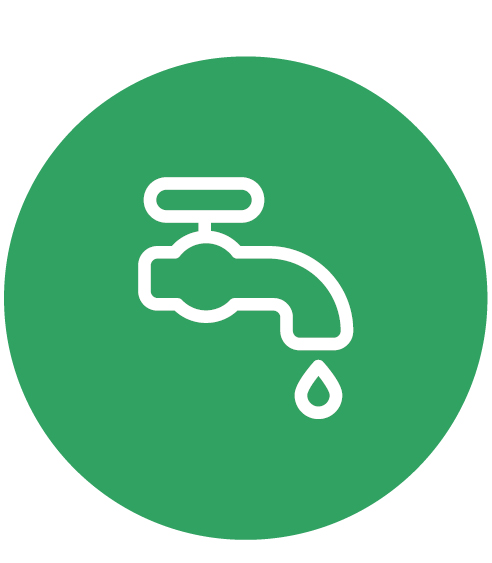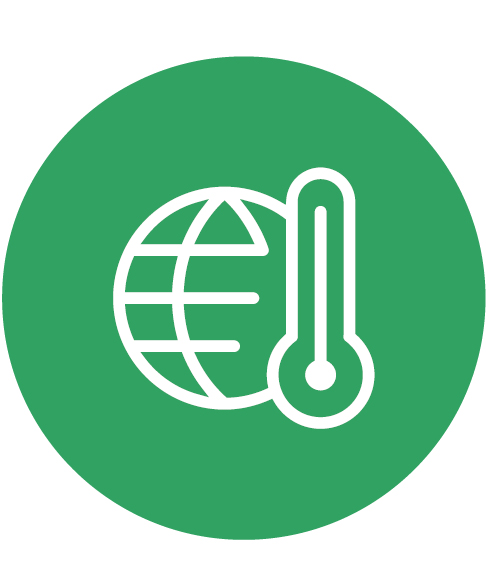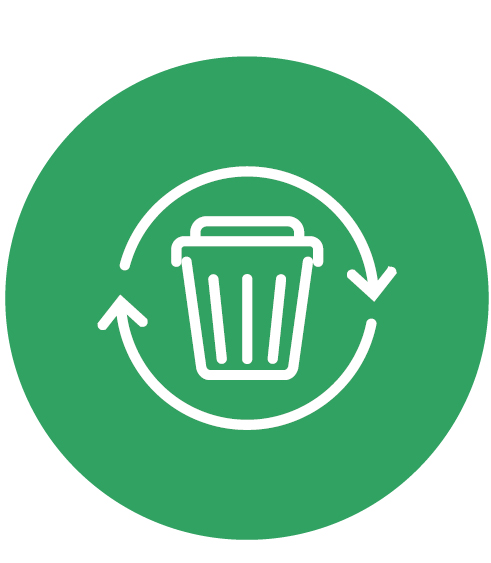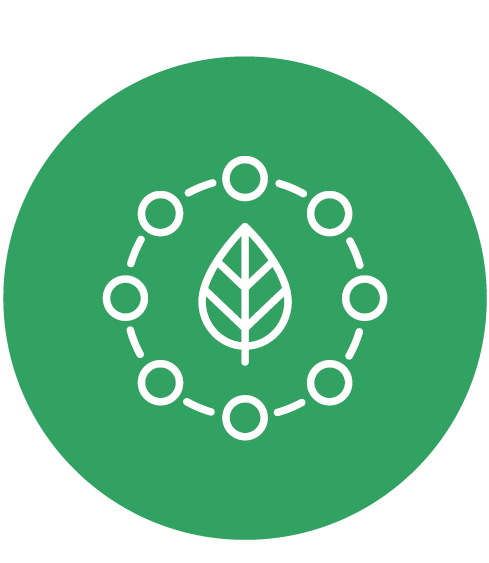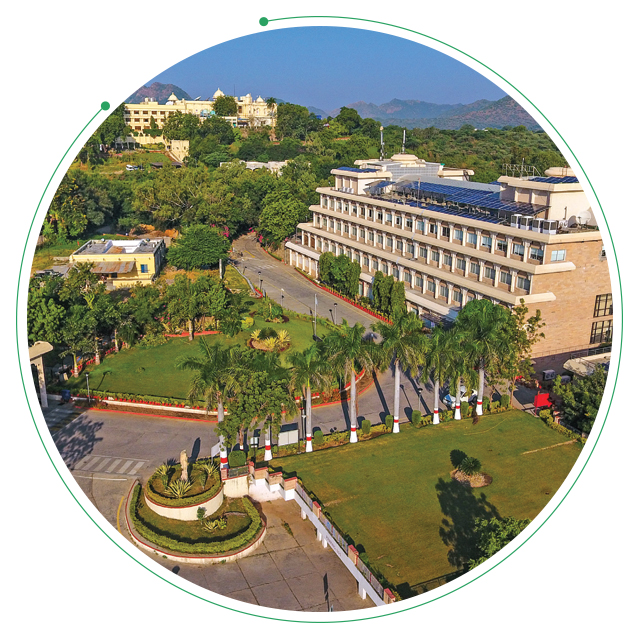ENVIRONMENTAL CARE
The key material issue associated
Water management
Priority of the
issue
HIGH
SDGs
associated


Tailing dams management
HIGH


Air emissions management
HIGH


Energy and climate change
HIGH
Solid waste management
MEDIUM
Biodiversity management
MEDIUM
Noise and vibrations management
MEDIUM
Use of recycled material
LOW
(All the GRI EN indicators cover all operating units of HZL.)
Being in the metals and mining sector, our business is closely interlinked with the natural ecosystem of the region where it operates. We reckon the impacts our mining and smelting operations have on the environment and we are also aware of the dependencies of our business on the natural resources.
At HZL, our policies and practices are not just limited to conserving the natural resources, we are also focussed on enhancing the quality of the natural environment of the region where we operate.

Our ambition
To be an industry leader in using green technologies for reducing our environmental footprint; this we envisage to achieve by innovating processes for water stewardship; introducing captive usage of energy from renewable sources; and adopting new methods for waste recycling

Our approach
- The three key constituents of our strategy for managing the environment are:
- Focussing on conservation of natural resources
- Minimising the environmental impacts of our operations
- Keeping our ecological footprint in check, and minimising the negative impacts, if any across the value chain
- Our environmental management process, driven by internationally recognised standards such as ISO 14001, ISO 50001, focus on key issues of water, waste, energy, emissions and climate change, as well as preserving biodiversity
- Our actions are guided by environmental policies, which include policies on water management, biodiversity
- management, HSE principles and policy, energy and climate change management
- Striving to go beyond compliance and setting industry benchmarks in environmental performance

Strategic priorities
- Work towards water stewardship in line with the United Nations Sustainable Development Goal SDG-6: water and sanitation to reduce fresh water use
- Evaluate opportunities to improve energy efficiencies or implement lower emissions sources
- Actions to achieve Sciencebased GHG emissions targets i.e 14% reduction in Scope-1 and Scope-2 and 20% reduction in Scope-3 by 2026 from the base year FY 2017
- Reduce carbon footprint through enhancing green energy portfolio
- Strengthening of zero liquid discharge at all locations
- Exploring opportunity for reducing, reusing and recycling of waste
Performance in FY 2019
- 1.10 Million m3 water saved
- 35.95% of total water requirement met by recycling and reuse
- Zero Category 4 (serious) and 5 (catastrophic), environmental incidents
- 64% waste recycled
- Total renewable energy consumed 46.52 Million GJ
- 69 Crore invested as environmental protection expenditure
- Globally ranked 1st in Environment dimension in SAM Dow Jones Sustainability Indices (DJSI) Corporate Sustainability Assessment amongst the metals & mining sector’
- Carbon Disclosure Project (CDP) climate change disclosure, CDP water disclosure scored B
Every project at HZL undergoes a thorough Environmental and Social Impact Assessment (ESIA) for environmental clearance. The mitigation plans are put in place for countering any potential impacts of the planned projects. Based on the impact assessment study, an environmental management plan is made which is revisited at regular intervals and appropriate corrective measures are taken. During the reporting period, we received no significant fines and no reports of non-compliance with environmental laws and regulations across our operations.
For the ongoing operations, we follow an internationally recognised management standard, ISO 14001. We have also adopted an international standard, ISO 50001 for managing energy at three of our units at Sindesar Khurd Mines (SKM), Pantnagar metal plant and Rajpura Dariba Mine.
Our environmental management practices are focussed on the following issues and we have taken several measures for addressing these issues. We set targets for each of these focus areas and direct our efforts towards implementing management systems and processes, adopting appropriate technologies and improving existing processes.
We acknowledge that water, although a renewable resource, is significantly scarce in the regions where we operate. As freshwater resources are constantly depleting, we have adopted a multi-pronged approach to manage water resources.





Minimising the use of water in operations
Increasing the use of recycled water
Developing rainwater harvesting systems to replenish ground water sources that we share with our communities
Our water management policy directs our actions on water management.
With a commitment for zero effluent discharge, the water management practices at HZL include:
- Reducing consumption at source
- Water utilisation efficiency
- Zero effluent discharge operation
- Water accounting
- Storm water management
Reducing consumption at source
Our operations are highly dependent on water and hence it
is important that water consumption at source is minimised.
Moreover, it is important to minimise the freshwater used.
For reducing process-related water consumption, we
have improvised several procedures and have modified
technologies for the same.
Some of these process modifications include:
- Using deep cone decanter to reduce water content in mine tailing disposal
- Installing air cooled condenser. It saves water consumption up to 95% when compared to traditional water-cooled condenser.
- Reducing freshwater use at the Demineralised (DM) water plant at Dariba Smelting Complex's lead plant by condensing the steam generated at the Captive Power Plant (CPP) at Dariba Smelting Complex's zinc plant
- Using harvested rainwater in operation
- Integrated effluent treatment plant at all smelters
- Technological upgradation by installation of Multiple Effective evaporator/Mechanical Vapour Recompression (MVR) at Debari and Chanderiya Smelters in place of conventional evaporators will strengthen zero discharge with improved water recovery
- Dry tailing disposal plant at Zawar mines is under execution and will ensure recirculation of >90% of the process water
- Initiatives to minimise water evaporation from water reservoirs
- Sewage treatment plant (STP) of 25 MLD commissioned; another 10 MLD and 5 MLD in progress
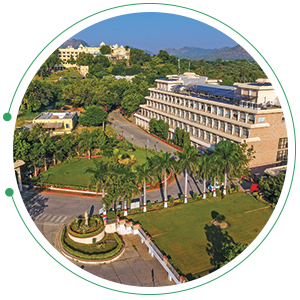

Case study
A meaningful step towards circular economy
Udaipur generates 70 Million Litres per Day (MLD) of sewage. Part of the cities selected under the Government of India’s Smart City Mission, Udaipur has benefitted from HZL’s endeavour to treat the city’s domestic sewage. Sewage inflow into Udaipur’s lakes was one of the biggest problems plaguing the 'City of Lakes' giving rise to high volumes of pollution. There was a need to develop alternative sources of potable water and conserve the same. Our units operate on the principle of ‘zero discharge’ and the Sewage Treatment Plants (STPs) represent a significant action taken towards conserving water as well as reducing discharge into the lakes.
Intervention
We commissioned a 20 MLD STP in Udaipur in 2014 under a public-private partnership, which is the first of its kind in Rajasthan. This required an investment of ` 170 Crore. HZL and Udaipur Smart City Limited signed an agreement in June 2017 to extend the sewage treatment capacity by another 40 MLD. Of the proposed 40 MLD STP, 25 MLD has been commissioned in January 2019. We have spent ` 80 Crore on this project so far.
Impact
At the 20 MLD STP, sewage water is treated through various
steps that include biological processes, wherein the end product
consists of treated water and manure. These are then used in
sludge thickening and dewatering units. Partly treated water is
also sent to rivers. Following the commissioning of the new STP,
50% of the water will be sent to the rivers.
Power consumption has also reduced on account of the fully
automatic plant and hydraulics mechanism. The process of
treatment is environment-friendly as well, since no hazardous
emissions are generated during the process.
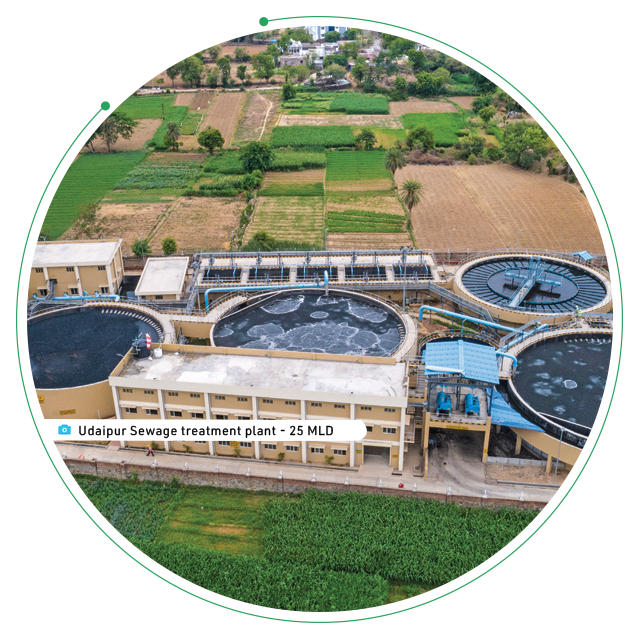
Measuring and managing water efficiently
By monitoring and measuring water consumption, any leaks or wastage in the process can be identified and managed.
Some of the key steps for better measurement and management of water are:
- Carrying out water risk assessment across all our operating sites
- Installing water meters at all key processes
- Online monitoring of water consumed at all the processes
Zero effluent discharge operations
All our operation sites maintain ‘zero effluent discharge’.
For achieving zero effluent discharge, we have installed
reverse osmosis (RO) plant and multiple effect evaporator.
Additionally, we focus on increasing use of recycled water by
installing integrated effluent treatment plants.
Waste water recycled
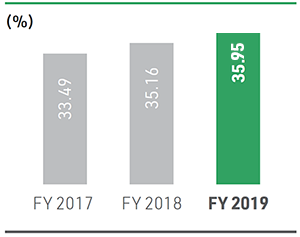
As our operations are located in water-stressed regions, we carry out risk analysis to identify operations where water is a critical issue. This enables us to reduce our impact on water stressed areas and identify different sources of water. For this, we engage with a team of external experts every year and water-stressed areas are classified based on WRI’s Aqueduct tools.
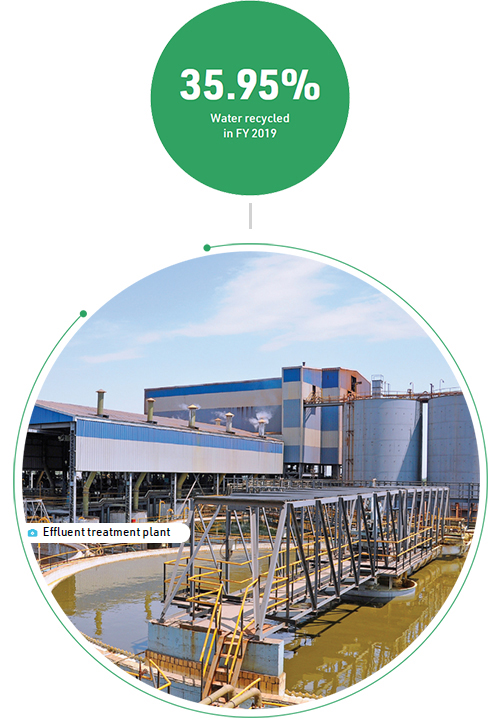
Stormwater management
HZL is committed to stormwater management and efforts are
in place to reduce runoff of rainwater and the improvement
of water quality. Stormwater collection pond is constructed
at all sites to collect rainwater runoff and treated in ETP
for reuse. We adopt rainwater harvesting not only at our
operations but at nearby communities as well.
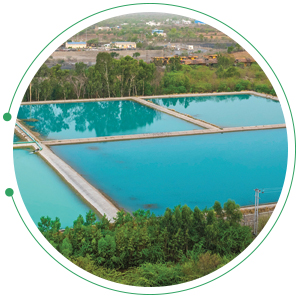

Case Study
Water conservation initiative around Rajpura Dariba Complex
To improve the water table in surrounding villages, in FY 2019, Sindesar Khurd Mines unit initiated a project for deepening a pond of capacity 5.32 Lakh m3 in the vicinity. The approximate project cost for this intervention was ` 3.5 Crore and is being executed by HZL’s civil department. Deepening work of 2.12 Lakh m3 has been completed so far, and the remaining 3.2 Lakh m3 is under way.
This initiative will have multi-faceted impact:
- The pond will be helpful for harvesting rainwater and recharge of ground water
- It will also be a water supply centre for the surrounding communities for various household needs and agriculture
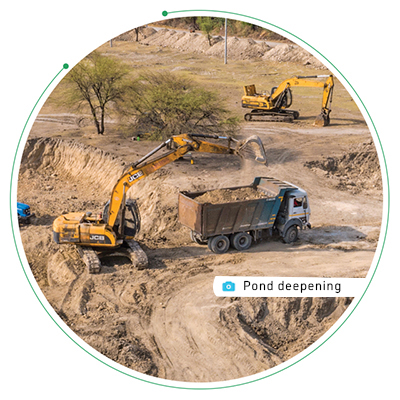
Total water consumption
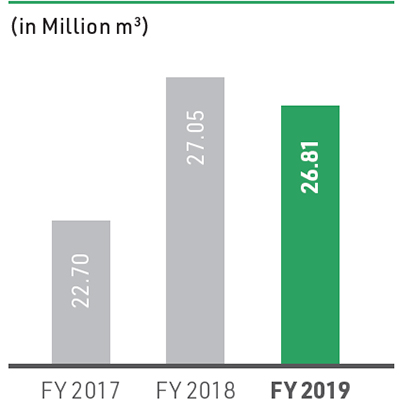
Specific water consumption
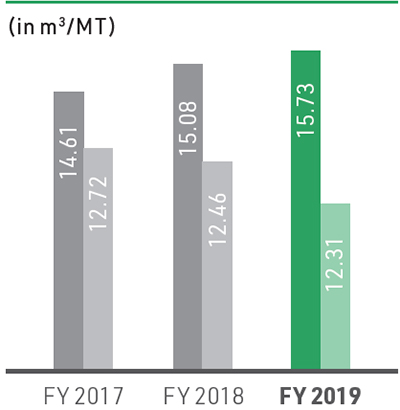
Increase in specific water has been observed due to variance in metal production and increase in the use of STP treated water but freshwater intake has reduced


Case Study
Effecting water conservation and recycling
As corporate citizens, we believe that the onus of being accountable towards the environment and society is upon us. We go beyond compliance with respect to our Corporate Social Responsibility (CSR) endeavours. We devote our attention towards the reduction of safety and environmental hazard during operations, while also laying emphasis on increasing the scope of water conservation and recycling.
What were the challenges
Our tailing dam area spans ~8.2 Lakh m3 and tailing from the Sindesar Khurd Mines and the Rajpura Dariba Mine
was being stored in the dam in the form of slurry. Water was then siphoned from the dam into a pit near our pump
house, following which it was pumped back into the Sindesar Khurd Mines. With increase in production following
the expansion of operations at Sindesar Khurd Mines, the volume of tailing was increased. The storage capacity was
under stress from rainwater during the monsoons, resulting in an overloading of the tailing dams. This raised safety
and environmental risks related to the dams. Further, there was no proper procedure for monitoring the water level
and displacement on the embankment.
How we intervened
We are making sure that the minimum volume of water finds its way into the tailing dams. This is made possible
by transferring large volumes of water into the newly constructed line storage pond, which has a capacity of
1.25 Lakh m3. Some parts of the water is also diverted to the mines for use in the ore beneficiation plant. To enhance
the levels of monitoring, three piezometers have been installed and installation of another five is under progress.
Inclinometer are installed to monitor movement in X and Y axis. Reading from both the instruments is being transferred
through GPS the to person in charge of the tailing dam. This aids in taking proactive steps against the occurrence of
unfortunate incidents. Installation of a camera on site adds to our security muscle.
What we achieved
Construction of 1.25 Lakh m3 capacity
lined storage pond:
- Reduced water losses due to evaporation, earlier more surface area was occupied by water in the dam
- Reduced safety and environmental risks due to more volume of storage
- All the reclaimed water is being used in ore beneficiation process
- tetet
Installation of Piezometers
- Piezometers are installed for measuring core water pressure in embankment of tailing dam. which is one of the important parameters to monitor health of embankment
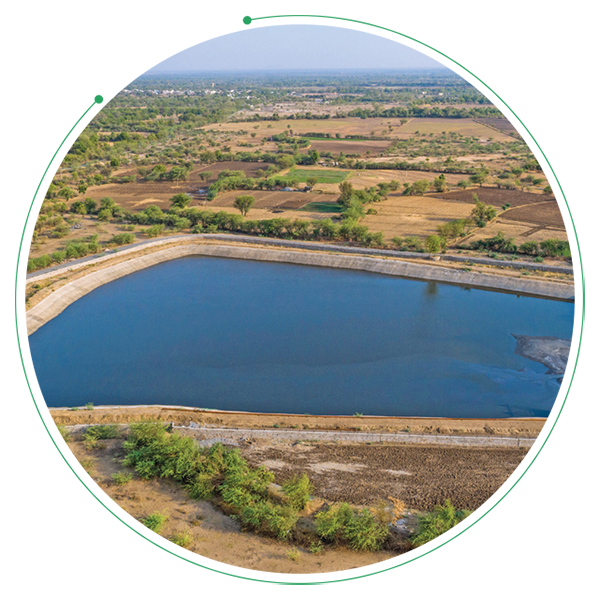
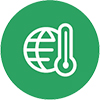
The metals and mining industry is energy intensive. Being a leading player in the sector, we have been proactive in adopting many practices for energy efficiency that are recognised as industry benchmarks. While we have adopted internationally recognised energy management standard ISO 50001 at three of our operating sites Sindesar Khurd Mines, Pantnagar metal plant and Rajpura Dariba Mine, we continuously focus on reducing overall energy consumption, improving energy, efficiency and using green energy which in the long run help mitigate climate change.
Some of the key initiatives for reducing energy consumption are:
- LPG heaters replaced by electrical burners at Pantnagar Metal Plant, to reduce LPG consumption during Jumbo Casting
- Installation of Vacuum Fluorescent Display (VFD) in sinter crusher ID fan, at Chanderiya Lead Zinc Smelter (CLZS)
- Replacement of existing street lights and metal halide lamps with LED lights
- Use of Roaster Air Blower for providing secondary air by stopping circulating air fan
- Cooling tower fan operation automation based on water temperature at Debari Zinc Smelter
- Installation of variable frequency drives to reduce auxiliary power consumption
- VFD installed in thickener underflow pump at Rampura Agucha Mine milling unit
- Occupancy Sensor installation at various offices and conference halls
- Switching from open-cast to underground mine at Agucha resulted in reduction of diesel consumption
- Switching from high speed diesel to pipe natural gas in Pantnagar
Specific energy consumption

Adopting green energy
HZL is also registering these projects at ‘Gold Standard’, the most rigorous certification standard globally for carbon offset projects supported by WWF.
HZL has made significant investment in green energy aggregating to 346.82 MW to reduce greenhouse gas emission and carbon footprint.
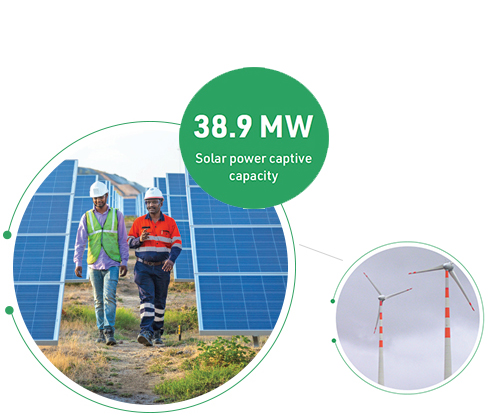
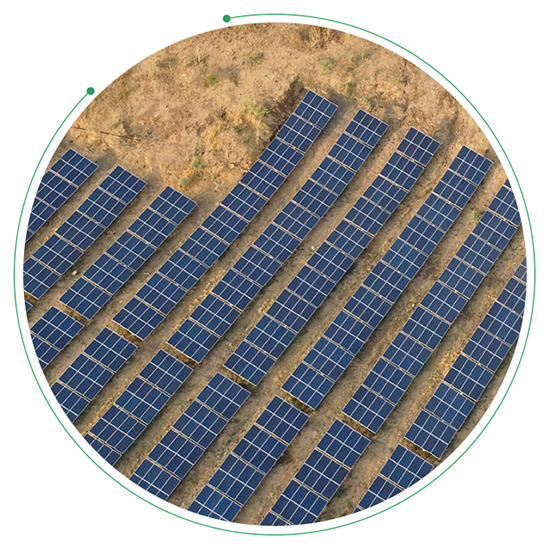
For our captive use, we commissioned a 22 MW solar power project on our waste dumps at Rampura Agucha taking the total to 38.9 MW. All solar power projects have been installed on land that otherwise had no possible use at Rajpura Dariba Mine and Debari Zinc Smelter. The green power generated has reduced carbon footprint by 66,049 MT of CO2 emission per annum. In addition, there is 34.4 MW of power capacity through waste heat recovery from roasters and steam turbo generator of which 9.4 MW/Waste Heat Recovery Boiler project is registered under Clean Development Mechanism, along with 21 TPH Low Calorific Value boilers for steam generation project.
We are planning to further enhance our solar energy footprint by another 35 MW in the coming year. This includes a 1 MW floating solar power project at a captive dam near Chanderiya, which will not only eliminate 5 acres of land usage, but also reduce water evaporation in a water stressed region. After completion of Fumer Project, it will generate 21 MW through waste heat recovery boiler, out of which 11 MW will be used in running the Fumer project and rest will be utilised for other operations or will be available for state grid.
Projects in pipeline
- 30 MW solar power project at Dariba
- 1 MW floating solar power project at Ghosunda Dam which will also help in the reduction of evaporation loss
- 3 MW roof top solar power project (0.75 MW already commissioned)
- Commissioning of waste heat recovery boiler at Fumer project
- Additional 50 MW wind power plant
HZL is committed to reduce absolute Scopes 1 and 2
GHG emissions 14% by 2026 from a 2016 base-year. We are also committed to reduce absolute Scope 3
GHG emissions 20% by 2026 from a FY 2017 base-year
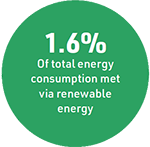
During the year, HZL produced solar power of 49.5 Million units, waste heat energy of 114 Million units and wind power of 465 Million units.
The 4 MW solar power project installed by HZL at Rajpura Dariba Mine is the first such project in the district of Rajsamand in Rajasthan. A 12 MW project installed at Debari Zinc Smelter is largest solar energy project in the district of Udaipur and 22 MW project installed at Rampura Agucha Mine is also the largest solar energy project in the district of Bhilwara. All the projects are installed on waste land, where no other activity could be done.
Recognition in the RE space
- Rampura Agucha Solar Project received Project Development Innovation of the year award by RE – Assets India 2019 conference
- Debari Solar Project received Gold Award in the Rising Category as Best Performing Project of the Year on Utility Scale Solar Energy at the RE ASSETS Excellence Awards Summit
Countering climate change
With our commitment to optimise energy consumption,
diversify our energy portfolio and invest in newer
technologies, we are trying to reduce our carbon footprint.
At HZL, we constantly invest in newer technologies that foster energy conservation. We participate in the Carbon Disclosure Programme (CDP), which calculates and reports Greenhouse Gas (GHG) inventory within a threefold scope as defined under the World Business Council for Sustainable Development and World Resource Institute GHG protocols. We are also committed to a science-based target initiative to set GHG emission reduction benchmarks, which are in harmony with climate science.

We have proactively implemented systems and procedures to address the concerns of our local communities and comply with our environmental licence conditions. Through advanced measurement, mitigation and management strategies, we continue eliminating any potential impacts on air quality caused by our operational activities.
To ensure that emissions generated from our activities is minimised, we have implemented a range of management procedures and controls including:
- Adequate stack height for better dispersion
- ouble Conversion Double Absorption (DCDA) in acid plant
- Clean technology-based Tail Gas Treatment plants for old acid plants to reduce SO2 emissions
- Eight field Electrostatic Precipitator (ESP) to minimise particulate matter emission from Captive Power Plants (CPP)
- Low NOx burners at CPP to minimise NOx emission
- Covered conveyor belts and material carrying trucks to prevent dust/fugitive emissions/spillages
- Regular watering of active mining areas and haul roads
- Track-mounted down the hole drills with wet drilling system
- Water sprays nozzles and Venturi scrubbers at crusher to collect dust
- Using washers, mechanised vacuum road sweepers and dust suppressants
- Perforated rubber hose pipe line laid inside the drilling level of the stope for dust suppression during mucking operation at Rampura Agucha Underground Mine
- Planting trees as buffers to minimise windblown dust
- Bag filters have been placed for reduction of fugitive emissions.
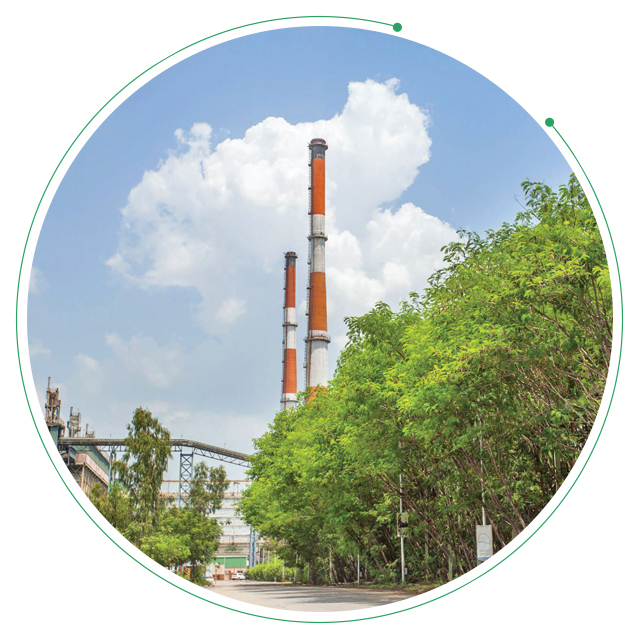
For regular air quality and meteorological monitoring both in core and buffer zones, HZL has installed online emission monitoring systems connected directly to the servers of Pollution Control Board.
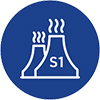
(Scope 1)
(Million MT CO2e)
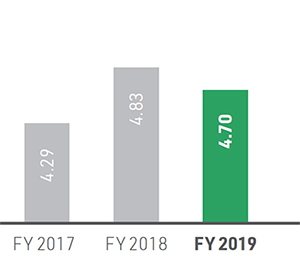
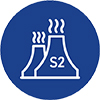
(Scope 2)
(Million MT CO2e)
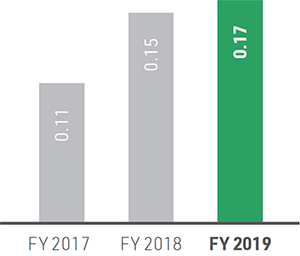
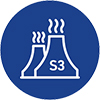
(Scope 3)
(Million MT CO2e)
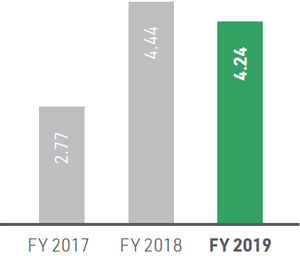

(scope-1 and scope-2)
(Scope-1 and Scope-2)
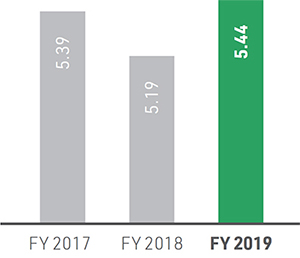
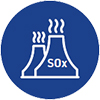
(MT)
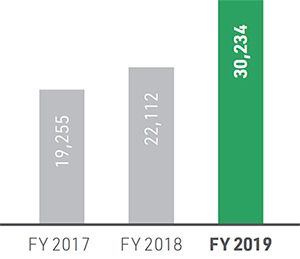
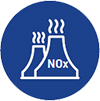
(MT)
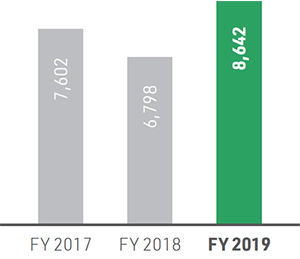
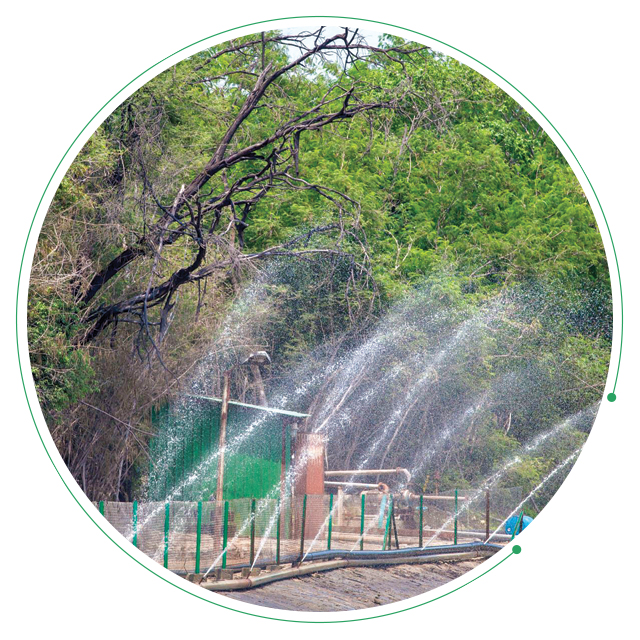
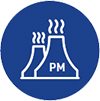
(MT)
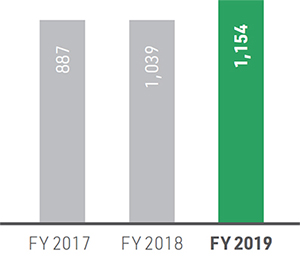

Our approach to ‘waste to wealth’
We follow the principle of reducing waste
generation at source and recovering and
recycling wherever possible. We have
rigorous waste management systems
in line with our waste management
guidelines to dispose hazardous and
non-hazardous waste while preventing
environmental contamination.
We have a ‘Waste to Wealth’ committee that explores opportunities to generate wealth from waste and achieve primary objectives of reduction of waste generation, conversion of residue material to saleable product and reduction of waste to landfills.
INITIATIVE
Jarosite and Jarofix are waste materials produced during the hydrometallurgical extraction processes at all three lead-zinc smelters Dariba, Debari and Chanderiya. Slag from the Imperial Smelting Furnace (ISF) is generated at Chanderiya during the refining process, while slag from the Fuming Furnace (FF) is produced at Dariba. Moore cake treatment plant slag is generated and stored at Debari. Large quantities of Jarosite and Jarofix are stored on site, causing risk to the environment and expanding the waste footprint of the organisation. Slag from pyro-metallurgical process compounds this problem.
In order to reduce the waste footprint of the organisation, various studies were carried out in relation to slag and its utility in cement and road construction. ISF and FF slags find use in the road and cement industry. Similar studies were also carried out in relation to Jarosite, which resulted in a positive turn and it was approved by Bureau of Indian Standards (BIS) for 1% utilisation in the cement industry. Jarofix was found to be suitable for road construction projects and as per approvals from Rajasthan State Pollution Control Board Indian Road Congress (IRC), Jarofix is being utilised in highway construction projects.
These efforts have been instrumental in rationalising the waste footprint of HZL, creating more space within the previously occupied areas. We have also been able to dispatch high quantity materials to road construction and cement industries.
We are continuously focussing on best practices for void management in our underground mines where we have doubled paste fill plant capacity in FY 2019 from 5.5 MTPA in December 2017 and will continue to add capacity. Good void management practices maximise the use of waste generated underground along with tailings from the mill and fly ash from CPPs.
We are also focussing on setting up paver block units, which can use slag, fly ash, bottom ash and Jarosite. We use large amounts of paver blocks in our operations. We are gainfully utilising a significant amount of these waste materials to cement and road construction industries.
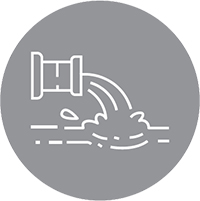
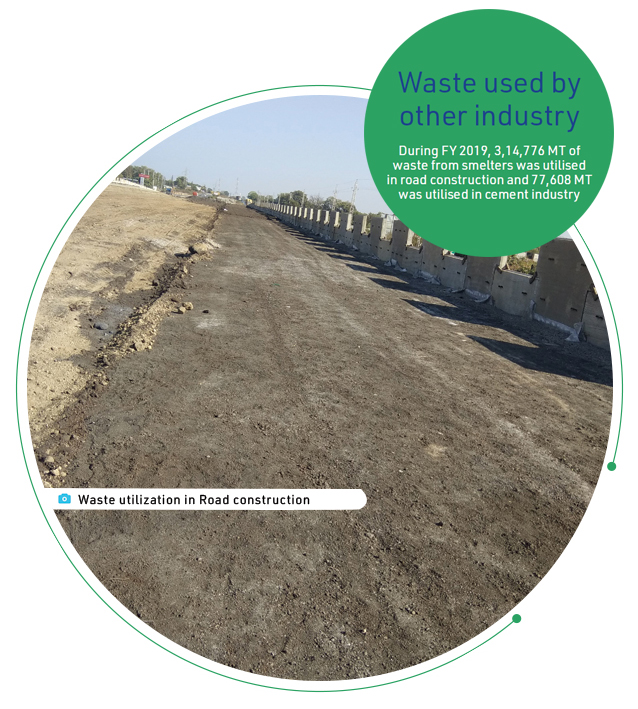
Among the many initiatives we undertook to manage wastes, some noteworthy steps have been:
- Laying of waste rock on our dedicated freight corridor railway double line works. Excess quantity after back filling was utilised for the same from Kayad Mine
- Fly ash, bottom ash and slag are utilised in cement and brick manufacturing units
- SKS fume dust leaching system was modified at Dariba Lead smelter, with a new process to control the off-gas dust composition and bleed off the impurities. This has led to reduction in waste generation like dust inventory and improvement in off-gas system reliability as well as equipment life
INITIATIVE
Zinc Smelter Debari recovers zinc from process residue waste and produces a non-hazardous solid waste called Waelz Kiln (WK) Slag generated at high temperature of over 1,000 °C., which is stored in slag yards. To gainfully utilise this slag, studies were done to establish its usage as sub-grade filling material for various construction activities, which has now been accredited by Indian Road Congress. To use this slag on a large scale, HZL started exploring the possibility of its usage in construction of national highways. Through continuous engagement with National Highway Authority of India (NHAI) and establishing lab scale testing, a breakthrough was achieved when NHAI agreed to use WK slag for sub-grade filling purpose after testing the strength and stability of road constructed with this slag. So far, ~57,000 MT of WK slag has been utilised in the construction of six-lane NH 27 and the usage is still continuing.
This initiative has not only helped in reusing waste but has also contributed to the preservation of natural ecosystem, which would have been hampered by NHAI’s soil excavation activities.

Case study
Engineering more value
Every year, we produce ~800 MT of antimony slag from the Chanderiya Lead Zinc Smelter (CLZS) pyro smelter. The slag contains 60% lead and 20% antimony. There is a need to improve the antimony realisation from the slag, since antimony is a commercially viable product. Moreover, there exists a huge demand for antimony trioxide on account of its utility as a flame retardant.
Intervention
Our Central Research and Development Laboratory (CRDL) devised a hydrometallurgical route to treat lead-infused antimony slag. The flowsheet for the same has been successfully validated at a pilot level. The pilot scale trials generated ~2 MT of antimony trioxide.
Impact
Antimony is recovered as antimony trioxide with more than 95% purity. The residue, which is full of lead, can be treated internally at the lead smelter. Overall, we have been able to achieve improved realisation from the slag, thus resulting in the extraction of valueadded products from the hazardous waste.
Process technology upgradation in Leaching
Plant at CLZS
Our conversion process in leaching plants allows impurities
to recycle back into the system and loss of zinc metal in
Jarosite with 3% zinc content. Through use of internal
resources involving no additional equipment, leaching
plant in one hydro-metallurgical smelter was modified by
eliminating weak acid leaching and incorporating a process
called Jarosite acid wash. This results in improved quality of
zinc sulphate purified solution with extremely low impurity
level and reduction in total zinc lost through Jarosite cake.
Post this modification, current efficiency in cell house of
smelter has improved to ~90% from 88% and total zinc loss
in Jarosite is reduced to ~2.5% leading to saving of about
` 22 Crore per annum at current LME level, along with
reduction in specific energy consumption. With further
improvements in automation for finer control of process
parameters, current efficiency of more than 92% can
be achieved which will increase savings by another
`10 Crore per annum.
This same process improvement is planned to be replicated at other smelters and total potential savings from this initiative will be about ` 100 Crore per annum.
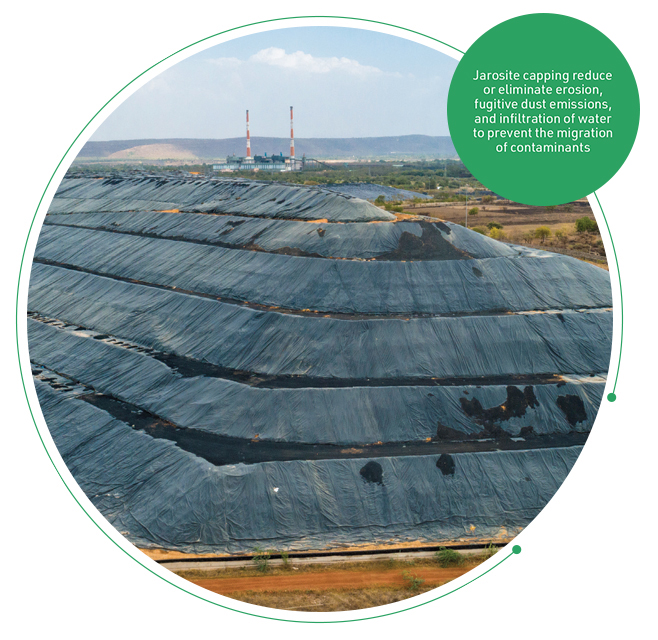

HZL is focussed towards generating wealth from waste. We have set up an ancillary plant in Dariba 5 years ago. The plant has helped in recovering value from waste and manufactures copper sulphate which is required for ore beneficiation at mines. A second ancillary unit is under construction at Chanderiya Lead Zinc Smelter premise which will also convert waste to consumable or saleable products.
After successful operation of ‘waste to wealth’ ancillary plant at DSC, a new ancillary unit has commenced construction at CLZS to treat all smelting process residue. The plant commissioning is expected in December 2019. The total cost of the project is ` 9.5 Crore and the payback for the project to be attained in 14 months. With the installation of this plant the expected cost savings in the range of ` 50-70 Crore per annum.
The waste material generated in metric tonnes per annum i.e. zinc oxide, antimony dross/dust (260), enrichment cake (527), purification cake (2997) and cadmium sponge (20)which be an input for the ancillary plant and will be producing value-added products such as zinc sulphate solution, antimony trioxide, cobalt filter cake, copper matte, lead bullion, lead-enriched cake and copper sulphate. This will help in reduction of our waste footprint and leap towards the sustainable environment.
Aiming to recover valuable metal lost
in zinc residue
HZL's first zinc Fumer project with a waste processing
capacity of 160,000 MT per annum is expected to
commission in FY 2020. The Fumer will lead to annual
recovery of valuable metals including 32 MT of silver
and 6,200 MT of zinc and lead from zinc residue, which
otherwise would be wasted in Jarofix. This initiative
will help move towards the goal of zero solid waste to
landfill and saving one hectare of land per annum.
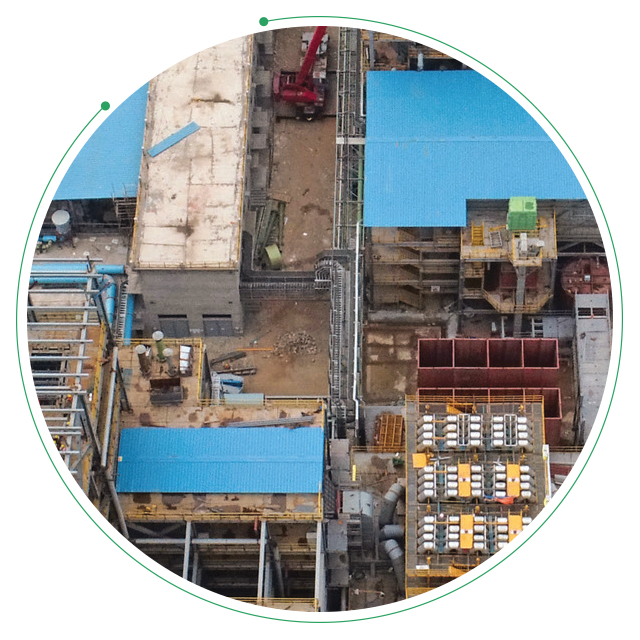
In response to recent highprofile tailings dam failures in the world, HZL initiated review of tailings storage facility standards, guidelines and risks and subsequently tailing management policy was rolled out during the year. Dam break stability studies are under progress in coordination with global experts. Tailing Storage Facility (TSF) community has been formed for driving actions to prevent similar incidents and ensure that best practices are implemented at all mining locations.
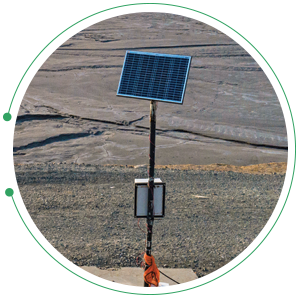
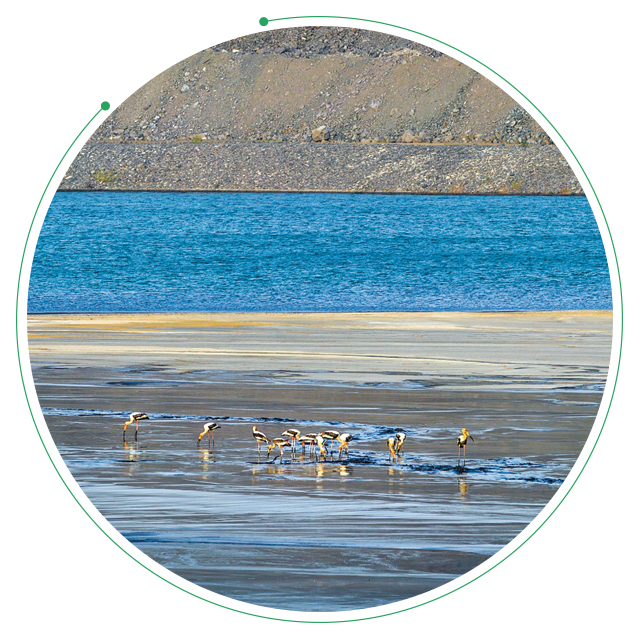
At HZL we have three active tailing storage facilities and all sites have a dedicated TSF manager and TSF committee consisting of a design engineer, operations, construction and environmental staff. All TSFs, as well as associated pipeline and pumping infrastructure, are subject to regular audit as well as regular inspection. In addition to tailing management policy, we also have organisation wide tailing management standard, which provides approach, methodology and guidance on tailings management.
Following actions were initiated by TSF community:
- Structured TSF organogram at each mine site and periodic review
- Replacement of wet tailing disposal system with dry tailing disposal system. Dry tailing disposal would reduce the water content in tailings which will help in improving the stability of dam
- Creation of secretariat at each location for ensuring availability of tailing dam related documents at single desk
- Dam break assessment
- Initiation of online monitoring of health of tailing dam embankment through vibrating wire type piezometers and inplace inclinometer

Case study
Stabilising dams for robust functioning
Generation of tailing from ore beneficiation process and its sustainable disposable is an integral part of our process of ore beneficiation in mining operations. We are optimising our disposal in tailing dam by increasing utilisation in backfilling of through paste fill plant. Remaining tailings in the form of slurry is being disposed at tailing dam.
Our operations require us to employ tailing dams. These are earth-fill embankments that are used to store by-products and waste materials left over from mining. It is imperative to regularly monitor the stability of these dams, while also ensuring that they are being efficiently used in accordance with their capacity.
What were the challenges
Water that came from liquid tailings and rain was accumulating at the tailing dam, increasing the risk of seepage through the bottom of the embankment. This also created concerns around stability. Additionally, with the tailing dams being at remote locations, efficiency audits were inconvenient.
How we intervened
- We erected a water collection reservoir with a capacity of 1.25 Lakh litres. This reservoir stores excess water accumulating at our tailing dams. In order to eliminate the need for physical inspections, we commissioned the installation of vibrating wire type piezometers and location-based inclinometers within the embankment. These instrumentation systems provide real-time monitoring information to our offices, which has boosted overall surveillance.
- We also structured a Tailing Storage Facility (TSF) organogram at each site wherein periodic reviews are carried out. Additionally, wet tailing disposal systems have been replaced with dry tailing disposal ones alongside creating a secretariat at each location, to ensure availability of documents related to tailing dam information at a single desk. Dam break assessments are also being carried out.
What we achieved
We have attained a certain degree of stability within our dams. Seepages at ground level are being trapped using shallow depth open wells constructed at the downstream side of the tailing dam area. Continuous pumping of water is reducing the charged water table, aiding in improving the stability of our dams. A total number of five open wells have been constructed and made operative at our locations. Dry tailing disposal system is also reducing the water content in tailing dams helping stabilise the process further.
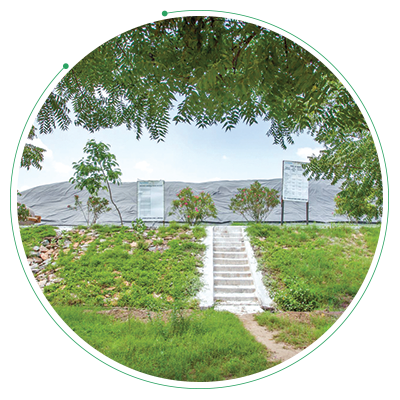
Waste generated
Non-hazardous*
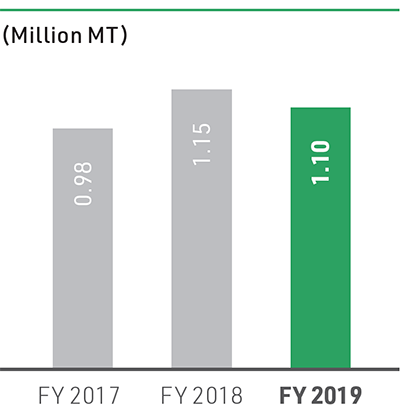
Hazardous
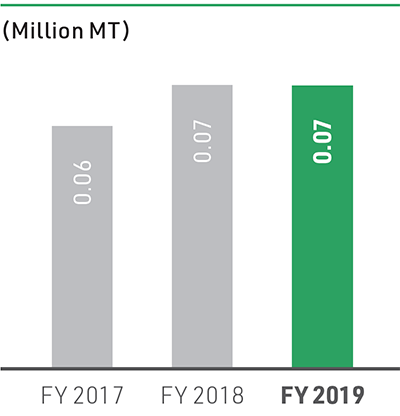
* Jarosite is now included in non-hazardous waste
Non‑hazardous is not including tailing and overburden

For every project we conduct a detailed Environmental, Social Impact Assessment, of which biodiversity risk assessment is an integral part. We then develop a Biodiversity Management Plan (BMP) to mitigate the identified risks.
Our specific biodiversity conservation efforts are not just based on the applicable regulations; we go beyond regulations in protecting biodiversity. We have engaged a third party for carrying out extensive study on biodiversity at all our units. Based on the initial biodiversity risk screening, we have developed a unique and exclusive BMP for all our operations. Our dedicated Biodiversity Policy and Management Standard advice how disruption to wildlife should be avoided, minimised or compensated for, from project scoping to site closure and beyond. Our aim is to achieve a minimum of No Net Loss (NNL) of biodiversity and Net Positive Gain (NPG) of biodiversity (in case any critical habitat is present) at all our operations.
Mapping biodiversity impacts and risks
of our operations
Geared with our commitment to protect the environment,
we have reviewed all our operations to identify their
proximity to International Union for Conservation of Nature
(IUCN) areas, important bird areas and key biodiversity hot
spots. We conducted a preliminary analysis of the type of
risks associated to the existent biodiversity in the vicinity
of our operations. We used the mapping tool Integrated
Biodiversity Assessment Tool (IBAT), for the screening
process and categorised our operations as high/medium/
low as per the associated risk category. The study confirmed
that most of our operations did not pose any threat to their
associated biodiversity.
During the year, Natural Capital Externalities Evaluation for impact on natural capital was conducted through CII at Dariba Smelting Complex, Chanderiya Lead-Zinc Smelter and all five mines. The objective of the assessment was to develop a baseline for natural capital impacts from operations and to track performance annually.
Biodiversity enhancement beyond boundaries
We take biodiversity preservation and enhancement
initiatives both in our operations and beyond our boundaries
in other locations. During FY 2016, we partnered with
Udaipur Urban Improvement Trust for regeneration of two
hills in the city- Ratnagiri and Kalimagri. During FY 2019,
~5000 trees were planted during the ‘Van Mahotsav’ on
17.91 acres of barren land of Ratnagiri and also on ~12 Ha.
at Kalimagri. We also supported the forest department in
the development of the biodiversity park in Udaipur.
We have planted more than 1.5 Million plants around our operations
During the year, 155,000 saplings were planted to increase flora density in the areas around our operations. Peacock conservation park, endangered plant nursery, butterfly garden, medicinal park, tree inventorisation, plantation on Kalimagri and Ratnagiri are few of the key projects for biodiversity management.

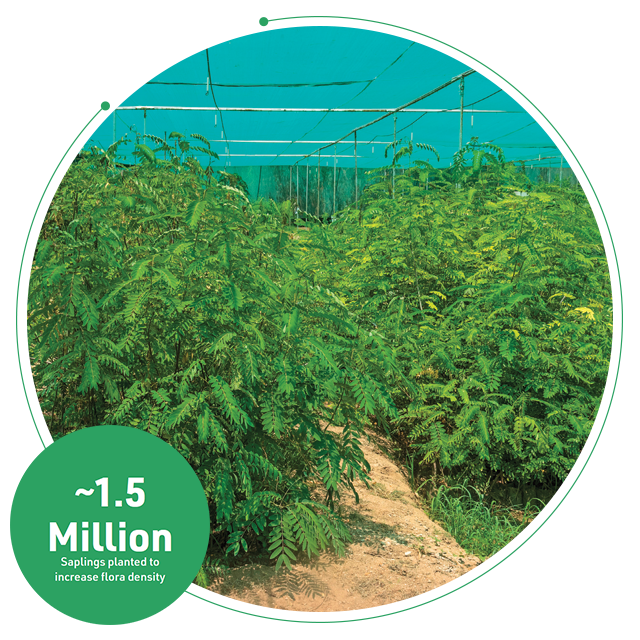
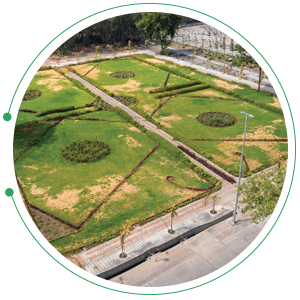
We planted ~60,000 saplings at Chanderiya for development of green area leading to the prestigious ‘Van Wordhak Prohatsan’ award from District Forest Department Chittorgarh.
Hindustan Zinc Jyotish Vatika was established at Debari Zinc Smelter. It comprises 27 nakshtra, 12 rashis and 9 grahas. This initiative is taken in line with our biodiversity management policy to conserve medicinal plants. Vatika labelled with a board, shows colours, plants and planets of each nakshtra and rashi.
Protecting and enhancing biodiversity is an integral part of HZL’s commitment to sustainable development. We have a separate policy on biodiversity and we stay committed to prevent risk on biodiversity throughout our business. To comply the policy, we developed butterfly-cum-rose garden in CPP Unit at CLZS as Implementation of Biodiversity Management Plan.
HZL, in joint agreement with Forest Department Udaipur, has conducted plant distribution programme to make Udaipur Green City. In this programme, various 20,000 fruit bearing and ornamental plants were distributed to various organisations and institutes like ‘Pukar Foundation’, Govt. and Private Schools, affiliated colleges of MLSU Udaipur, Rama Phosphate, IIM Udaipur and Udaipur Military cantonment.






